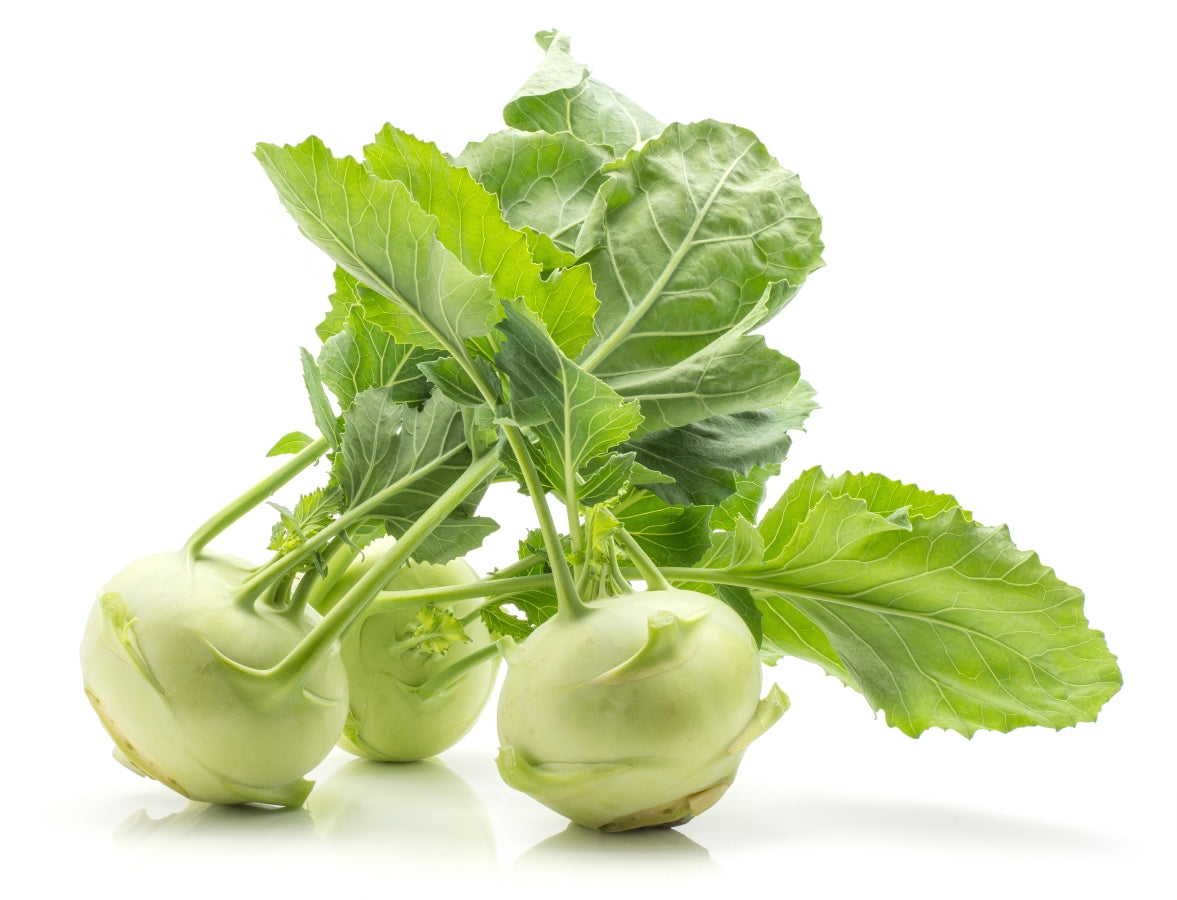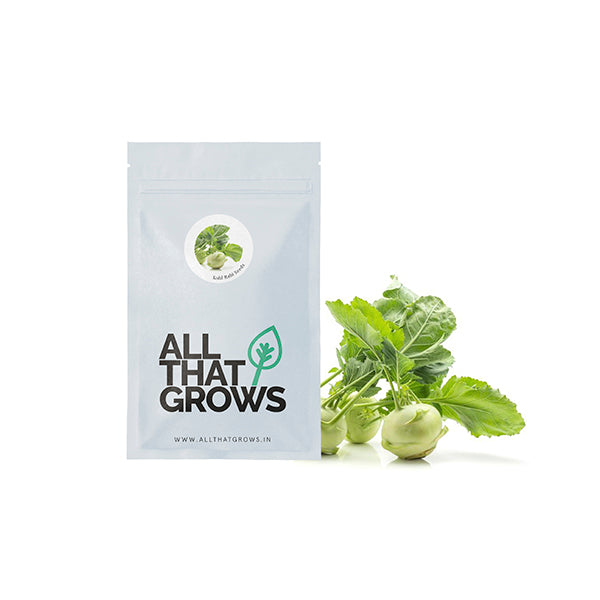



Kohl Rabi Seeds
Seed Type : Non-Hybrid, Open Pollinated and Non-GMO
Plant type : Dwarf, short topped
Foliage : Medium green, 5-6 small leaves/knob,
Knobs : Round, light green, crispy, sweet
Maturity : After 60 days from transplanting
Sowing Time: September to October (or as per your local climatic conditions).
- SOWING
TIMESep - Oct
(or as per your
local climatic conditions). - Sowing
DistancePlant to plant - 12"
Line to line - 9" - Fruit
Weight150-200 gms
- Fruit
Shaperound
- Days to
maturity60 days after
transplanting
- Details
- How to sow
- Reviews
Native mainly to Germany, Italy, Spain, and England, Kohl Rabi is also found abundantly in Asia, Canada, and Northern USA. It is another vegetable from the cabbage family with similar origins as the brocolli, cauliflower, kale, and brussels sprout. With looks that resemble the turnip and flavor that reminds of cabbage, Kohl Rabi has a sweet and succulent taste with a crisp and crunchy texture. A far as its nutritional value is concerned, the bulbous Kohl Rabi that grows in cooler climes, is extremely beneficial and healthy to consume.
Kohl Rabi by far has the richest source of Vitamin C, more than any citrus food you can think of. One serving of this vegetable is enough to give you a power dose of this potent antioxidant that will help in strengthening the immune system while keeping the skin supple because of collagen release . It also helps fight iron deficiency, regulate metabolism, aids in digestion, prevents the risk of developing cancer, protects vision, and also enhances bone health while keeping the nerves and muscles functioning in top shape.
To eat Kohl Rabi, just stem off the leaves at both ends, peel like a potato and either have it raw in salads or cook it in a curry with choicest spices. Kohl Rabi can also be boiled, steamed or blanched depending on how you like it best.
Planting instructions
For a spring crop, sow seeds directly 4 to 6 weeks before winter ends
Plant 10 seeds per ft at ¼ inch deep
For transplanting, the seedlings should be around 4 inches tall and planted 5 inches apart in rows 1 ft wide.
Keep plants well watered and free of weeds.
Work carefully to prevent damaging the delicate, shallow roots.
Growing Requirements
watering
Keep soil evenly moist. Kohlrabi that goes without water becomes woody.
pests
The pests that attack this crop include Cutworms, Cabbage loopers, Imported cabbage worms. The above mentioned pests feed on the underside of leaves, leaving ragged holes sometimes. They suck fluids from the plant leaving a honeydew substance behind, causing them to either die or become dwarfed when young or defoliated if mature.
soil
Kohlrabi should be planted in well-tilled soil enriched with compost having pH between 6.5 and 6.8.
spot
It needs at least 6 hours of full sun each day; more the better.
temperature
Kohlrabi grows best in cool temperatures ranging from 4 -23°C [40°F and 75°F].
how to harvest
Harvest kohlrabi stems when they are new and tender, usually about 2 1/2 to 4 inches in diameter.
Harvest by cutting them from the root of the plant.
You can snip the leaves from the stem and save them to cook separately.
Kohlrabi can be kept for 2 to 3 weeks in the fridge.

The productiveness of any seed we sell is subject to your local climatic conditions*, the sowing method you adopt, and your commitment to the planting process. We give no warranty, expressed or implied, and are in no way responsible for the produce.
Please note that all our seasonal recommendations/ sowing information is as per the local climatic conditions. *For more information on the optimum conditions required for growing seeds in your region, please contact us at, hello@allthatgrows.in or Whatsapp us at, +91 8544865077
Questions & Answers
Have a Question?
Be the first to ask a question about this.




Kohl Rabi Seeds
Seed Type : Non-Hybrid, Open Pollinated and Non-GMO
Plant type : Dwarf, short topped
Foliage : Medium green, 5-6 small leaves/knob,
Knobs : Round, light green, crispy, sweet
Maturity : After 60 days from transplanting
Sowing Time: September to October (or as per your local climatic conditions).
Native mainly to Germany, Italy, Spain, and England, Kohl Rabi is also found abundantly in Asia, Canada, and Northern USA. It is another vegetable from the cabbage family with similar origins as the brocolli, cauliflower, kale, and brussels sprout. With looks that resemble the turnip and flavor that reminds of cabbage, Kohl Rabi has a sweet and succulent taste with a crisp and crunchy texture. A far as its nutritional value is concerned, the bulbous Kohl Rabi that grows in cooler climes, is extremely beneficial and healthy to consume.
Kohl Rabi by far has the richest source of Vitamin C, more than any citrus food you can think of. One serving of this vegetable is enough to give you a power dose of this potent antioxidant that will help in strengthening the immune system while keeping the skin supple because of collagen release . It also helps fight iron deficiency, regulate metabolism, aids in digestion, prevents the risk of developing cancer, protects vision, and also enhances bone health while keeping the nerves and muscles functioning in top shape.
To eat Kohl Rabi, just stem off the leaves at both ends, peel like a potato and either have it raw in salads or cook it in a curry with choicest spices. Kohl Rabi can also be boiled, steamed or blanched depending on how you like it best.
Seed Type : Non-Hybrid, Open Pollinated and Non-GMO
Plant type : Dwarf, short topped
Foliage : Medium green, 5-6 small leaves/knob,
Knobs : Round, light green, crispy, sweet
Maturity : After 60 days from transplanting
Sowing Time: September to October (or as per your local climatic conditions).
- SOWING
TIMESep - Oct
(or as per your
local climatic conditions). - Sowing
DistancePlant to plant - 12"
Line to line - 9" - Fruit
Weight150-200 gms
- Fruit
Shaperound
- Days to
maturity60 days after
transplanting
Planting instructions
For a spring crop, sow seeds directly 4 to 6 weeks before winter ends
Plant 10 seeds per ft at ¼ inch deep
For transplanting, the seedlings should be around 4 inches tall and planted 5 inches apart in rows 1 ft wide.
Keep plants well watered and free of weeds.
Work carefully to prevent damaging the delicate, shallow roots.
Growing Requirements
watering
Keep soil evenly moist. Kohlrabi that goes without water becomes woody.
pests
The pests that attack this crop include Cutworms, Cabbage loopers, Imported cabbage worms. The above mentioned pests feed on the underside of leaves, leaving ragged holes sometimes. They suck fluids from the plant leaving a honeydew substance behind, causing them to either die or become dwarfed when young or defoliated if mature.
soil
Kohlrabi should be planted in well-tilled soil enriched with compost having pH between 6.5 and 6.8.
spot
It needs at least 6 hours of full sun each day; more the better.
temperature
Kohlrabi grows best in cool temperatures ranging from 4 -23°C [40°F and 75°F].
how to harvest
Harvest kohlrabi stems when they are new and tender, usually about 2 1/2 to 4 inches in diameter.
Harvest by cutting them from the root of the plant.
You can snip the leaves from the stem and save them to cook separately.
Kohlrabi can be kept for 2 to 3 weeks in the fridge.



 Sign In
Sign In








